Links
http://www.transoxiana.org/14/smagulov-demidenko-ancient_chach-rus.html
Authors
Dr. Sergey V. Demidenko, Scythian-Sarmatian Department, Institute of Archaeology, Russian Academy of Science, Moscow, Russia.
Aisulu A. Erzhigitova, Southern Kazakhstan Regional Museum, Shymkent, Kazakhstan. e-mail: aisulu6767VIAmail.ru
Posting Foreword
The Siyavush Dynasty was one of miracles of the world, it was ubiquitous in the Central Asia for nearly a millennia, and it set a model repeated many times over after its demise, including the Ashina dynasty and the last of them Chingizid dynasty, that occupied leading roles just because they were of Ashina or Chingizid root. How ingrained the name Siyavush is in the culture of the Central Asian people is manifested by the continued popularity of that name in history and at present. The origin of the dynasty is cloaked in time, but it is known that it appeared a good millennium before the Sarmats came to the attention of the first Greek historians, at the time when Central Asian steppes rebound after a millennium of desiccation and desolation. The replacement population consisted of a mix of the original Uraloid hunter-gatherer population that left the Central Asian river valleys for cooler and wetter Ural mountains area, but may have survived in some less hostile pockets; the farming migrants from the south, supposedly from Khorasan, Afganistan, and Peshavar, who established settled agriculture in the river valleys; and the pastoral nomads who introduced local pastoralism around farming oases. By the time the Turkestan city-states came to the attention of the historians, they had long-established peculiar "Sprachbund" or areal grouping of languages known under the terms of Chorasmian and Sogdian, the dynastic line that ruled all realms in the area, and symbiosis of farming-trading oases with nomadic pastoralists. Archeologists uncover two distinct cultures and populations, one of settlements and non-kurgan necropolises with sprinkling of nomadic ware and kurgans, and the other of kurgan necropolises with sprinkling of non-kurgan ware, pointing to both symbiotic relations and distinct lifestyles. As should be expected, the stability of populations is different, the clock on the nomadic side runs much faster than on the oasis side.
The Sarmatian history in the last century experienced a turn to reality. What started as a stationary model of sedentary populations applied to mobile pastoralists acquired a flavor of nomadic actuality, the continued in situ three-stage self-contained development was replaced by migration-driven demography, conditionally labeled "Early Sarmatians" and "Late Sarmatians". Both Sarmatians remain Kurganians with traits peculiar to Tengrianism, but their cultural and anthropological appearance in the archeological relicts leaves different footprints. The "Late Sarmatians" are Sarmatians with a greater doze of migrants from the east, replanted into the S.Urals and amalgamated with the "Early Sarmatians". Their heads are universally deformed, men and women. They carry more Mongoloid traits than their predecessors, like shorter sheens and shovel-shaped incisors. And the men are mounted riders, with contortions caused by the life in a saddle. Majority are close to the modern Uraloids descending from the earlier Sarmatians, meso-brachicranial relatively gracile with moderately profiled slightly flattened lowish face. Visit Kazan, and you will meet them in any grocery store. The amalgamated migrants are of the gracilized northern variation of the Pamir-Fergana morphology, meso-broad-brachicranial with sharply profiled face and strongly protruding nasal bones, but with some Mongoloid traits similar to the Caucasoid population of the Hun-time Central Asia and Kazakhstan, whose origin is tentatively connected with the Huns, but might as well be Kangars, Tokhars, Usuns, or any other osteologically similar population. Migration of these nomads was not a new phenomenon, it was also detected in the previous centuries, by the "Late Sarmatian" time they were already indigenous and acculturated. The third proportionally minor type resembles modern Armenian Caucasoids, they were typologically identical to the aboriginal people of the Armenian highland of the 17th-16th cc. BC., before the mass migration of Indo-Iranians to Mesopotamia. Mount a blend of these three types on the horses, give them Sarmatian armor and arms, and we have the people that left us Sarmatian and Siyavush tamgas.
At some point Chach realm disintegrated into a constellation of fiefs producing their own coins. For considerable time, Chach belonged to the Kangar state and may have used tamgas of its suzerain. Coins also were privately minted on behalf of allodial rulers. And on top of that, the changes of the nuclear element in the ruler's tamga points to a change of the ruling dynasty. The haziness of the political and dynastic status however does not undermine the validity of the Sarmat paradigm.
In the deep thought of some scholars with aversion to the Türkic word tamga and its inescapable meaning, the Orwellian substitute euphemism "tamga-like signs" sounds much better, ostensibly sanitizing it beyond recognition, so that it can be extended to the people who had no use of tamga whatsoever. Most likely, the term "tamga-like signs" has an immortal life, because no Sarmatian is going to rise from the grave to testify that "tamga-like" is in fact the very same tamga. Too bad that the trick does not work, the proponents can't even fool themselves, the donkey ears tend to stick out from under most skillful wraps.
Posting notes and explanations, added to the text of the authors and not denoted specially, are shown in (blue italics) in parentheses and in blue boxes.
Origin of Ancient Chach Dynasty
(Middle Syrdarya Region)
During field leveling survey in the vicinity of Shymkent in 2008 was chanced upon a bronze cast cauldron together with gilt torque necklace 1. These two artifacts seem to be interesting for the study of the regional history.
The torque is apparently made of a single smooth copper rod clad with sheet gold. The rod in the middle is 4mm, and 2mm thick at the ends. The torque diameter with latched ends is 14.5ñì. The clasp has a shape of a hook extruded of the rod polyhedron terminal with no clear boundary. The other terminal is flattened into a plate with central round hole for latching. The shape of the plate is unclear, a large section of it is missing. Torque weight is 44.2 g (Fig. 1/1).
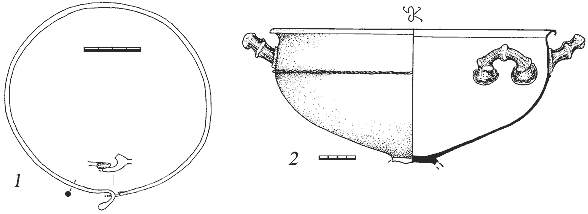
Similar torques are found mainly in the European part of the Eurasia. Thus, similar torque of pure gold is in the exposition of the Ukraine Museum of Historical Treasures in Kyiv (No. DM-1635). Its date and provenance remain unknown, however it has practically identically shaped clasp with one terminal in a hook shape and the other is flattened with a central round hole. Its golden ball pendant is decorated with granulated geometric patterns (triangles, circles). 2 The torque has no parallels in Scythian and Sarmatian antiquities. However, the boll pendant looks very much like also found in Ukraine balls of contemporaneous pendants decorated with granulated geometrical patterns dated by 7th c. AD. 3 Practically identical artifact was found in the burial kurgan of Romonya I tomb 237 dated by the end of the 7th c. AD. 4
Of the cauldron remains only a strongly deformed semispherical body, damaged most probably by a bulldozer blade (Fig. 1/2). Some cauldron fragments are missing and those present are badly indented. The cauldron wall is 1 – 2 mm thick. Apparently, the cauldron had a missing conical base, traceable by circular (4 cm in diameter) joint line. The artifact is bronze-cast of a reddish hue. During casting (or lifetime?) the cauldron cracked at the bottom and then was repaired. On the cauldron shoulder is a similar defect.
The cauldron body is of flattened semispherical shape with bent post-forged thin rim. Rim diameter is approximately 32-34 cm; body height is 15-17 cm. The cauldron is embossed with twisted cord ("string") pattern around the 45 sm maximum diameter of the body below the rim. A small distance above the pattern are two ribbed loop-shaped handles with tree projections welded at an angle to the body on the opposite sides. Around the base of handle are traceable characteristic casting joints (Fig. 1/2). The height of the handles is 4.3-4 cm, and the distance between their feet is 4 cm. The rim of the cauldron is smoothly bent out and apparently was additionally forged. The external surface of the cauldron is covered with uneven parallel relief grooves diverging from the bottom of the cauldron to its rim. The surface inside the cauldron is smooth. Judging from the visual examination, the cauldron is cast as a whole, i.e. the body, handles and bottom were cast in a single casting mold.
Bronze cauldrons are fairly rare in Central Asia and Kazakhstan. The closest analogy comes from a Gardani Hisor settlement (Tajikistan), which yielded a large fragment of solid-cast cauldron analogous to the Shymkent exemplar in a number of features. It was found on the floor of a room dated from ceramic and coins found there by the 7th – early 8th centuries AD. 5 A number of clay cauldrons fragments similar to the Shymkent cauldron, also with semispherical body and horizontal loop-shaped handles with tree projections,, dated to the 7th -8th centuries are common in Ak-Tobe I (settlement), Kyrgyzstan. 6
At the same time the Shymkent cauldron has a number of morphological and technological features, liken it to the Scythian and Uysun cauldrons cast earlier, in the 5th -1st centuries BC, and Sarmatian cauldrons dated by the 2nd c. BC – mid of the 3rd c. AD However the rims of the Scythian and Sarmatian cauldrons have never been additionally forged. The parallel vertical grooves are traces of organic plant frame that protected from damage the melt-and-burn model of the vessel while being encased in clay mold 7 were found on the surfaces of both Sarmatian and some Scythian cauldrons, analogous the surface of the Shymkent cauldron. In Kazakhstan and Kyrgyzstan, on the early Iron Age bronze cauldrons horizontal handles are common. 8 At the same time horizontal handles were predominant for fairly limited period of time (few centuries before our era) and are ascribed by the researchers to the oriental influences, 9 embossing Sarmatian cauldrons with double-string rope pattern also was widespread in the 2nd c. BC – mid of the 3rd c. AD.
From both morphological and technological similarities and differences of the features we may conclude that the subject cauldron provenance is the vicinity of Shymkent. Considering the above it may be safely suggested that the site where were found cauldron and torque dates by the early Turkic age, the 7th c. AD. But in view of the fact that such artifacts (cauldrons, torques) are uncommon in the Syr-Darya region of Kangar (Orig.: Kanguj, with Chinese accent) times and are poorly classified by date, the possibility of dating this site to an earlier period can't be excluded.
Right in the middle between the handles on the inner surface of the bent rim is engraved a small tamga-like symbol (Fig. 2/à; 3). The symbol has dimensions of 18 õ 20 mm. Tamga consists of an oval-shaped element in the center with unclosed ends slightly curved inward and one line smoothly curved upwards at the terminal. Two symmetrical lines are curved downwards, the right leg is curved, and the curving of the left leg is not shown probably because this part of the curve is depicted on the sharply bent edge surface.
|
Fig.
2. Tamgas on cauldrons: a - cauldron rim, kurgan near Shymkent, 2008; b - Sarmatian cauldrons (Demidenko 2008) |
Fig.
3. Clan/family tamga on the rim of the cauldron from the kurgan near Shymkent (photo of Sergey A. Yatsenko, 2008) |
 |
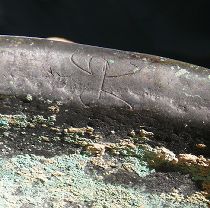 |
|---|
Appearance of tamga, especially on the rim of a bronze cauldron, is generally linked to the role of cauldrons in culture and mainly in ideology of the ancient "nomadic peoples". In addition, this tamga is obviously related to the tamgas engraved on the most ancient group of "early Chach" coins, where they are attributes of a "dynastic emblem" of the "ruler of the Chach people (community?)", 10 who ruled in the ancient Tashkent region. Scholars date minting of coins with such tamga in the Chach/Shash region to the period from the end of the 3rd to the beginning of the 6th centuries AD. 11 This tamga is also found on the ancient coins of Sogd (from the second half of the 2nd c. BC) and Chorasmia/Kwaresm (from the 1st c. BC). 12 It should be noted that graphic design of this tamga is so distinct that it has no exact analogies even in a exhaustive collection of Caucasian tamgas (1,384 tamgas), many of which, according to a convincing statement of L.I. Lavrov, have "genetic relations with the Sarmatian, Nogai, Tatar, and Central Asian tamgas". 13 However, similar graphics appears on the tamgas engraved on coins and on many other property objects found in Central Asia.
As is well known, steppe tribes of the Asiatic Sarmatia 14 played significant role in Transoxiana ethnogenetic processes of ancient times. A great number of studies based on written records and archaeological sources deal with the role of Sarmatian tribes in the Transoxiana historical development and ethno cultural genesis. 15 In this line of investigation the tamga signs have long been acknowledged to be of special informative value. 16 It is well known that funeral rituals of the Sarmatians, which differ from those of, let’s say, the Saka people, include depositing of cauldrons in the burial. 20% of all found cauldrons were found in the earthen kurgans over the burials, probably this is the case with the subject cauldron. Sarmatian cauldrons are also distinguished by "tamga-like" signs cast on the cauldron bodies. 17 Some of these signs are similar or related to the symbols on the ceramic jars and coins of Late Antiquity and Early Middle Age Transoxiana. 18 Among the emblems that appear on the cauldrons, which obviously can be treated as "tamga-like signs" (Fig. 2/b), there is none quite similar to the tamga engraved on the early Chach coins, but from our point of view between them is a certain relationship.
It has long been acknowledged by the scholars that ("royal", "clan") tamgas used as symbols of power or ownership in the states established by the Sarmatians (or any other Türkic people for that matter) have a composite character with a nucleus and additional elements. 19 Only additional elements are subject to variations in number, direction, composition, and graphics, while the nucleus remains unchanged. Tamgas with unchanged nucleus and varying additional elements constitute distinct series, a comparative analysis of which may serve as additional argument for some (naturally, hypothetical) conclusions subject to a proper evidence of source studies. In case with "early Chach tamga" we may suggest that variations in number and arrangement of the additional elements stand for family/clan division. If we admit existence of some "syntax rules" in forming dynastic seals (tamgas) (for instance, symmetry rule), then from the review of the variations it can be seen that these rules limited additional elements in number from 0 to 4, which could be depicted in ones or twos in upward or downward direction from the central element.
The early Chach/Shash tamga, genetically related to the Late Sarmatian tamgas (The keyword qualification is "Late Sarmatian", i.e. the eastern migrants into the S.Urals territories, with a dynamic of a reciprocal motion, the "Late Sarmatians" from the east migrating westward and then expanding eastward from the west) that we are seeking to establish, is such a composite emblem consisting of a central oval with open terminals slightly curved inwards (element 1, "ellipsoid") and three lines curved upwards and downwards from the oval. In the synopsis of such emblems on the coins we find a distinct series of tamgas of the early Chach state ruling family/clan 20 (Fig. 4/b) from the end of the 3rd to the beginning of the 6th centuries AD. The Chach series includes two different positions for the upper curve depicted above the oval, and at the same time inside the ellipsoid appear dots or crosses, which apparently individualize the common clan/dynasty tamga. 21 A general review of the Sarmatian emblems 22 clearly shows that the curved inwards lines are the most productive elements for tamga modifications; they were probably used to distinguish tamgas of smaller divisions of a tribe (clan or family). Variations of "Chorasmian Siyavushid" dynastic tamga mainly differ from each other in the shape of their base with constant nucleus. 23 Notably, the tamga of the principal Samarkand dynasty was formed following the same pattern, i.e. it has identical additional elements with the Chach tamga, but its nucleus has a shape of a circle. 24 (Implying a genetically unrelated dynastic line)
But first ought to be established the Sarmatian origin of the tamga. For that, among the Sarmatian "tamga-like signs" should be located its prototypes within a sufficiently representative collection of obviously Sarmatian origin artifacts bearing a representative series of tamga-like signs.
These conditions are satisfied by such Sarmatian artifacts as cast bronze cauldrons, which usually come from undisturbed burial complexes predominantly of the elite type. The Sarmatian cauldrons' tamgas have a tamga similar to the central element of the Chach tamga (Fig. 2/b, 12, 18). It is depicted in two positions with the ellipsoid open terminals in upward or downward direction. 25 The synopsis of the late Sarmatian tamgas may be complemented with a unique tamga engraved on the horse golden harness found in the Pokrovka 2 necropolis (kurgan 9) on the river Ilek. This burial kurgan is dated by the second half of the 3rd c. AD 26 The tamgas are depicted on square wooden badges inlaid with golden foil and clearly depict heraldic emblem (just like the coins). Assuming that a single harness complement was deposited in the burial (?), the find contained three versions of this tamga that differed by two additional elements – upper curves (Fig. 4/à,3-5) (Traditionally, fully harnessed sacrificial horses are brought along by the participants of the funeral ritual, so a variety of harnesses should be expected, but not all sacrificial horses are buried with the deceased, most of them are impaled around the kurgan grave in a running position; the harnesses of horses impaled on the surface are hard to recover; similar tamgas mark the harnesses from different families of relatives; the buried tamgas belong to the deceased or his immediate family).
| Fig. 4. Tamgas on various artifacts: a – horse harness badges from Pokrovka 2 burials kurgan 9 (according to Malashev, Yablonsky, 2008); b – early Chach coins of group 1 (Shagalov, Kuznetsov 2006). |
Circa 500 - 600 AD(?) King of Chach/Asbar(?), AE Drachm(?) Central tamga (upside down); Sogdian(?) legend around. |
|
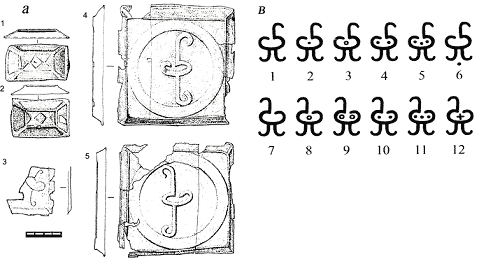 |
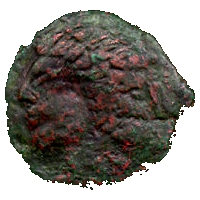 |
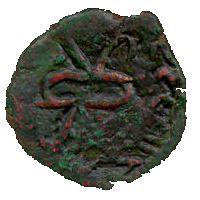 |
|---|---|---|
Based on these finds and being very much aware of the weakness of any hypotheses founded on formal coincidence, hypothetically can be reconstructed the "development line" (or "distinct series") that reflects the origin of the "early Chach tamga" from the Sarmatian tamga on bronze cauldrons (Fig. 2/b, 12, 18), via tamgas on Ilek horse harness (Fig. 4/à, 3-5) to tamgas on the early Chach coins of group 1 (Fig. 4/b). The tamga-like emblem on the Shymkent cauldron is probably a late specimen of the Chach dynastic tamga, and its provenance shows the location of the clan from which the dynasty descended from (Fig. 2/à).
Migration of Sarmat tamgas, along with other artifacts and phenomena (such as zoomorphic handles of ceramic ware, anthropomorphic amulets, mirrors, some types of weapons, etc.) into the culture of Kangar (Orig.: Kanguj) people in the middle course of Syr-Darya is also demonstrated by other signs. For example, Sarmatian ancient relics include cult objects marked with arrow-shaped tamga (or "bird paw"). Among them is a round altar from Southern E.Urals (Chkalov necropolis, kurgan 4, grave 3). Along with other signs five arrow-shaped emblems are depicted in a circle on the wide ring of the altar surface (Fig. 5/3). Although the researcher, dating this burialby the beginning of the 4th c. BC, he doesn’t hold this sign as tamga 27, yet it is worth to turn to another Sarmatian bronze cauldron found in the Aral Sea region, with this emblem cast on four sides of the body (Fig. 5/2). 28 At the turn of eras and in the first half of the 1st millennium AD an "arrow-shaped" emblem appears among other markings on the household ceramic discovered at historical sites in the north-eastern Transoxiana 29, this emblem is also cast on a bronze mirror found in the tomb of the ancient town Sidak necropolis (6th -8th cc. AD; near city Turkestan in South Kazakhstan province) (Fig. 5/1). 30
1- bronze cast mirror from the ancient city Sidak necropolis tomb 1;
2 - bronze cauldron from Aralsk Museum (Boroffka et al. 2005);
3 - Sarmatian altar from Southern E.Urals (Tregubov 2000) (actually, dinner plate with 3 legs)
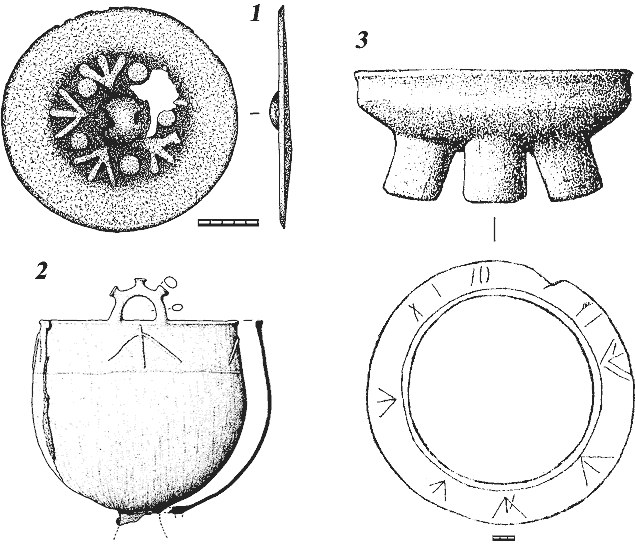
Thus, the hypothesis on the origin of an ancient princely dynasty that ruled in the 4th -5th cc. AD, or probably even earlier, in the urbanized by that time Tashkent oasis and descended from one of the tribes of the Late Sarmatian Culture, is consistent with our knowledge of the ethnic and cultural processes in the vast territory of the formerly powerful Kangar (Orig.: Kanguj) state. Probablyly, the same origin had the tribal union, a descendent of which was the Chach dynasty with the domain area of the upper courses of the rivers Badam, Sajramsu, Kochkarata, and Arys. According to V.Yu. Malashev, the original homeland of the Late Sarmatian Culture nomadic tribes were the Central Kazakhstan semi-deserts or the Northern Kazakhstan steppes. 31 The artifacts and rituals of their culture do not conflict with this conclusion. 32 Around the middle of the 2nd c. AD these tribes migrated to the South E.Urals region and almost immediately migrated to the west (steppes in the basins of Lower Itil and Lower Don). Later they probably expanded toward the south (Syrdarya valley).
B.I. Vainberg substantiates the origin of all modifications of the Siyavish (Orig.: Chjaovu, with Chinese accent) dynasty tamga from the Yuezhi tribe, which ruled Chorasmia, Samarkand and Bukhara, and Sogd, from the tamgas of the "Early Sarmatian" tribes (in the wide sense). 33 But in this case it is irrelevant, because the origin of the "Early Sarmatians" (mid. 2nd - 1st cc. BC) and the "Late Sarmatians" (mid 2nd - mid 3rd cc. AD) are connected with different groups of the Asian nomads.
Bibliography
Alimov K.A., Bogomolov G.I., 2000. On the Problem of the Ethno-cultural Contacts of the Nomads of Bukhara and Chach Regions (K voprosu ob etnokul’turnykh kontaktakh kochevnikov Bukhary i Chacha) – History of the Material Culture of Uzbekistan (Istoriya material’noi kul’tury Uzbekistana), Vol. 31, Sasignand.
Boroffka N. and oth., 2005. Ein Kessel aus dem Vorland des Aral-See – Eurasia Antique,Band. 9. Berlin.
Bubnova M.A., 1963. Ak-Tobe I Medieval Settlement near Orlovka Village (Srednevekovoe poselenie Ak-Tobe I u sela Orlovki) - Archaeological Monuments of Talas Valley (Arkheologichskie pamyatniki Talasskoi doliny) (Ed. by N. Kozhemyako). Frunze.
Demidenko S.V., 2008.Bronze cauldrons of the ancient tribes of the Lower Volga region and Southern E.Urals (the 5th c. B.C .– the 3rdc. AD) (Bronzovye kotly drevnikh plemen Nizhnego Povolzh’ya i Yuzhnogo Priural’ya (V v. do n.e. – III v. n.e.). Moscow.
Demidenko S.V., Demidenko Yu.V. (In print). On the Problem of Interactions of Trans-Volga region, Northern Caspian Sea Coast and Transoxiana in the Last Centuries BC (K voprosu o svyazyakh Zavolzh’ya, Severnogo Prikaspiya i Srednei Azii v poslednie veka do nashei ery) (In print).
Dratchuk V.S., 1970. On Tamga-Type Signs Studies of the Porth Pontic Periphery of the Ancient World (Ob issledovanii tamgoobraznykh znakov severopontiiskoi periferii antichnogo mira) – Ancient History Herald (Vestnik drevnei istorii), 1970/4, Moscow.
Dratchuk V.S., 1975. S.Systems of Signs of the Northern Black Sea Coast (Sistemy znakov Severnogo Prichernomor’ya). Kyiv.
Filanovitch M.I., 1991. On Interpretation of Burials in the Lower Horizon of Shashtepa in Tashkent (K interpretatsii pogrebenii v nizhnem stroitel’nom gorizonte Shashtepa v Tashkente) - History of the Material Culture of Uzbekistan (Istoriya material’noi kul’tury Uzbekistana), Vol. 25, Tashkent.
Filanovitch M.I., 1999. On the Problem of Migration Routes of the Early Nomads [Chach and Sogd on Route of Nomads to Bactria] (K voprosu o putyakh dvizheniya rannikh nomadov [Chach i Sogd na puti kotchevnikov v Bakrtiyu]) - Study of the Cultural Heritage of the East. Cultural Traditions and Continuity in Development of the Ancient Cultures and Civilizations. Abstracts of the International Conference (Izuchenie kul’turnogo naslediya Vostoka. Kul’turnye traditsii i preemstvennost’ v razvitii drevnikh kul’tur i tsivilizatsii. Materialy mazhdunarodnoikonferentsii). St-Petersburg.
Ilyasov J.Yu., 2007. On origin of tamga of the Sasignand governors (O proikhozhdenii tamgi sasignandskikh pravitelei) – Abstractsof the International Workshop devoted to 2750 Anniversary of Sasignand (Materialy mezhdunarodnogo seminara, posvyashchennogo 2750-letiyu Sasignanda). Tashkent, Sasignand.
Ilyasov J.Yu., 2009. Nomad Heritage: Kushan Tamga-Signs from Southern Uzbekistan -Traditional Marking Systems: Presence, Symbolism and Usage (Ed. by J. Evans Pim, O. Perrin, S.A. Yatsenko). London, 2009.
Kiss A., 1977. Avar Cemeteries in County Baranya – Cemeteries of the Avar Period (567-829) in Hungary. Vol. 2. Budapest.
Kuznetsov A.V., 2007. Kuznetsov A.V. Sequence of the Coinage of Some Groups of the Coins of Chach of the 7th -8th centuries (Posledovatel’nost’ vypuska nekotorykh grupp monet Chacha VII-VIII vv.) – Transoxiana– Maverannahr (Ed. by E.V. Rtveladze). Tashkent.
Lavrov L.I., 1978. Historic and Ethnographic Brief History of the Caucasus (Istoriko-etnograficheskie ocherki Kavkaza). Leningrad.
Litvinsky B.A., 1968. Sarmatian and Kang-Ku’ Hvarnah (Sarmatsko-kangyuiskii farn). Dushanbe.
Malashev V.Yu., Yablonsky L.T., 2008. Steppe Population of Southern E.Urals in the Late Sarmatian time (Stepnoe naselenie Yuzhnogo Priural’ya v pozdnesarmatskoe vremya). Moscow.
Malashev V.Yu., Moshkova M.G., 2009. Origin of the Late Sarmatian Culture (Statement of a Problem) – Establishing of the Late Sarmatian Culture. Materials of Seminar of the Center of Study of the History and Culture of Sarmatians (Stanovlenie pozdnesarmatskoi kul’tury. Materialy seminara Tsentra izucheniya istorii i kul’tury sarmatov) (Ed. by V.M. Klepikov). Vol. III. Volgograd.
Minasyan R.S., 1986. Bronze Cauldrons Casting of the Eurasia’ Steppe Peoples [the 7th c. BC – the 5th c. AD] (Lit’e bronzovykh kotlov u narodov stepei Evrazii [VII v. do n.e. – V v. n.e.] - Archaeological Collection of the State Hermitage (Arkheologicheskii sbornik Gosudarstvennogo Ermitazha), Vol. 27. Leningrad.
Obel’tchenko O.V., 1967. Burials of Sarmatian type near Sasignand (Pograbebiya sarmatskogo tipa pod Sasignandom) – Soviet Archaeology (Sovetskaya arkheologiya), 1967/2.
Ol’khovsky V.S., 2001. Tamga [on Sign Functions] (Tamga [k funktsii znaka]) - Historical and Archaeological Almanac (Istoriko-arkheologitcheskii al’manakh), Vol. 7, Armavir, Moscow.
Rtveladze E.V., 2000. On Early Coins of Chach (Chach) and on Actual Name of This Region (O rannikh manetakh Chacha [Chacha] i o podlinnom nazvanii etoi oblasti) - Archeology, Numismatics and Epigraphy of the Medieval Transoxiana (Arkheologiya, numizmatika I epigrafika srednevekovoi Srednei Azii) (Ed. by Kh.A. Amirkhanov), Sasignand
Rtveladze E.V., 2006. History and Numismatics of Chach (Istoriya i numizmatika Chacha). Tashkent.
Scythian Gold. Museum of Historic Treasures of Ukraine, 1992. Tokyo.
Shagalov V. D, Kuznetsov A.V., 2006. Catalogue of the Coins of Chach, the 3rd-8th centuries. Tashkent.
Skripkin A.S., 1990. Asiatic Sarmatia (Aziatskaya Sarmatiya). Saratov.
Smagulov E.A., Erzhigitova A.A., 2004. Grave Constructions of Sidak Necropolis (Pogrebal’nye sooruzheniya nekropolya Sidak) - Proceedings of the Ministry of Education and Science, National Academy of Sciences of Kazakhstan Republic (Izvestiya Ministerstva obrazovaniya i nauki, Natsional’noy Akademii Nauk Respubliki Kazakhstan). Social Sciences. 2004/1.
Smaguov E.A., Yatsenko S.A., 2006. Signs and Pictures on the Pottery from Sidak in Middle Syrdarya Region (Znaki i risunki na keramike Sidaka so Sredney Syrdar’i) – Turan-Turkestan: problems of the cultural and historic succession. The Proceedings of the International Conference devoted to the 10th anniversary of Turkestan archaeological expedition (Turan-Turkestan: problemy kul’turno-istoricheskoy preemstvennosti. Materialy mezhdunarodnoy nauchnoy konferentsii, posvyashchennoy 10-letiyu deyatel’nosti Turkestanskoy arkheologicheskoy expeditsii) (Ed. by T. Ryskeldiev). Turkestan.
Solomonik E.I., 1959. Sarmatian Signs of the North Black Sea Region (Sarmatskie znaki Severnogo Prichernomor’ya). Kyiv.
Spasskaya E.Yu., 1956. Copper Ñauldrons of Early Nomads of Kazakhstan and Kirghizia (Mednye kotly Kazakhstana i Kirgizii) – Memoirs of Alma-Ata State Teachers-training Institute. Human sciences (Uchenye zapiski Alama0atinskogo gosudarstvennogo pedagogitcheskogo institute. Gumanitarnye nauki), Vol. XI/1. Alma-Ata.
Spasskaya E.Yu., 1958. Finds of the Copper Cauldrons in Kazakhstan and Kirghizia (Nakhodki mednykh kotlov v Kazakhstane i Kirgizii) -Memoirs of Alma-Ata State Teachers-training Institute. Social and Political Sciences (Uchenye zapiski Alama0atinskogo gosudarstvennogo pedagogitcheskogo institute. Obshchestvennye i politicheskie nauki), Vol. XV/2. Alma-Ata.
Tolstov S.P., 1947. From Prehistory of Russia [Paleoethnographic Study] (Iz predistorii Rusi [paleoetnographicheskie etyudy]) – Soviet Archaeology (Sovetskaya arkheologiya), Vol. VI-VII.
Tolstov S.P., 1963. Central Asian Scythians in the Light of the Latest Archaeological Discoveries (Tsentral’noaziatskie skify v svete noveishikh arkheologicheskikh otkrytii) - Ancient History Herald (Vestnik drevnei istorii), 1963/2.
Tregubov V.E., 2000. Sarmatian Sacrificial Altars from Museums Collections of Ural Region (Sarmatskie zhertvennye altari iz muxeinykh sobranii Priural’ya) - Cultural Heritage of Steppes of the Northern Eurasia (Kul’turnoe nasledie stepei severnoi Evrazii). Orenburg.
Vainberg B.I., 1977. Coins of the Ancient Chorasmia (Monety drevnego Khorezma).Ìoscow.
Vajnberg B.I., 1999. Ethnogeography of Turan in Antiquity (Ethnogeografiya Turana v drevnosti).Ìoscow.
Vainberg B.I., Novgorodova E.A., 1976. Notes on Signs and Tamgas of Mongolia (Zametki o znakakh i tamgakh Mongolii) - History and Culture of the Peoples of Transoxiana: the Antiquity and the Middle Ages (Istoriya i kul’tura narodov Sredney Azii: drevnost’i srednie veka) (Ed. by B.A. Litvinsky). Moscow.
Yablonsky L.T., 2000. Yablonsky L.T. Main Migration Processes in the Southern Aral Sea region in the Early Iron Age (Glavnye migratsionnye protsessy na territorii Yuzhnogo Priural’ya v rannem zheleznom veke) – Lower Volga Archaeological Herald (Nizhnevolzhskii arkheologicheskii vestnik), Vol. 3. Volgograd.
Yablonsky L.T., Devis-Kimball G., Demidenko Yu.V., 1995. Excavation of Pokrovka 1 and Pokrovka 2 Barrow Necropolises in 1994 (Raskopki kurgannykh mogil’nikov Pokrovka 1 i Pokrovka 2 v 1994 godu) – Barrows of the Left Bank of Ilek (Kurgany levoberezh’ya Ileka). Vol. 3 (Ed. by A.V. Shestakova). Moscow.
Yakubov Yu.Ya., 1987. Bronze Medieval Cauldrons of Tajikistan (Bronzovye srednevekovye kotly Tadzhikistana) – Material Culture of Tajikistan (Material’naya kul’tura Tadzhikistana), Vol. 4. Dushanbe.
Yatsenko S.A., 2001. Tamga-Signs of the Iranian Peoples in the Ancient Times and Early Middle Ages(Znaki-tamgi iranoyazychnikh narodov drevnosty i rannego srednevekov'ya). Moscow.
Yatsenko S.A., 2009a. Problems and Methodic of Study of Nishan-Signs of the Ancient and Early Medieval Iranian-Speaking Peoples of Eurasia" - Traditional Marking Systems: Presence, Symbolism and Usage(Ed. by J. Evans Pim, O. Perrin, S.A. Yatsenko). London, 2009.
Yatsenko S.A., 2009b. On Discussion about the Rise of the Ethnic-cultural Unities of the Nomads of Asiatic Sarmatia in the Second Half of the 2nd– First Half of the 3rdcc. AD (K iscussii ob oformlenii etnokul’turnykh obshchnostei kochevnikov Aziatskoi Sarmatii 2-i pol. II – 1-i pol. III vv. n.e.)– Establishing of the Late Sarmatian Culture. Materials of Seminar of the Center of Study of the History and Culture of Sarmatians (Stanovlenie pozdnesarmatskoi kul’tury. Materialy seminara Tsentra izucheniya istorii i kul’tury sarmatov) (Ed. by V.M. Klepikov). Vol. III. Volgograd.
NOTES
1 . Apparently, the earthen kurgan fill covering a small kurgan that are abound in the vicinity of the city has been plowed over. The find was received from a local man for expert examination by the Regional Museum of Local Lore. Unfortunately, there is no other information on its archaeological background.
2 . Scythian Gold 1992. No. ¹134.
3 . Ibid. Ns. 183, 184.
4 . Kiss 1977, p. 120-121.
5 . Yakubov 1987, p. 135-138, fig. 1-2.
6 . Bubnova 1963, p. 138, fig. 9/11-15.
7 . Minasyan 1986, p. 61-78; Demidenko 2008, p. 27-40.
8 . Spasskaya 1956; 1958.
9 . Demidenko, Demidenko (In print).
10 . Rtveladze 2000, p. 147-149.
11 . Kuznetsov 2007, p. 121.
12 . Vainberg 1977, p. 34-42, 73-74, 76; Yatsenko 2001, fig. 28-29.
13 . Lavrov 1978, p.108-123, pl. 1.
14 . Skripkin 1990, p. 201-208.
15 . See, for example: Tolstov 1963, p. 42-43; Litvinsky 1968; Obel’tchenko 1967, p. 181-187; Filanovitch 1991, p. 77-87; 1999, p.124-125; Alimov, Bogomolov 2000, p. 164-177; Yablonsky 2000, p. 68-73.
16 . See, for example: Tolstov 1947, p. 45-49; Vainberg, Novgorodova 1976, p. 66-75; Ol’khovsky 2001, p. 75-86; Yatsenko 2001; 2009a; Ilyasov 2009.
17 . Demidenko 2008, p. 137, fig. 1; On fig. 2/b tamga like signs are shown on Sarmatian cauldrons. Tamgas are grouped by us in graphic -related groups; Ns. preserved according to S.V. Demidenko.
18 . Yatsenko 2001, fig. 27-29.
19 . See, for example: Drachuk 1970, p. 134-147.
20 . Rtveladze 2006; Shagalov, Kuznetsov 2006, p. 291-292.
21 . Asymmetry in the form of the basic Chorasmian tamga (Ò4; Ò1-2 and Ò4-5), according to B.I.Vainberg, "reflects tamga belong to different, though also closely related tribes, families or "sub-dynasties": Vainberg 1977, p. 35.
22 . Solomonik 1959; Dratchuk 1975; Yatsenko 2001.
23 . Vainberg 1977, p. 34-38.
24 . Ilyasov 2007, p. 146-149.
25 . Demidenko 2008, p. 137, fig. 1/ 12, 18.
26 . Yablonsky, Devis-Kimball, Demidenko 1995, p. 44, fig. 64, 67; Malashev, Yablonsky 2008, p. 50; Burial has been plundered in antiquity, therefore it is impossible to precisely define now the arrangement of plates on horse the harness; it is also impossible to identify how many harnesses were buried in the kurgan. We show plates in the table (fig. 4/à), turning them around 180°.
27 . Tregubov 2000, p. 57-72, fig. 1-4.
28 . Boroffka N. and oth. 2005.
29 . Smagulov, Yatsenko 2006.
30 . Smagulov, Erzhigitova 2004. p. 285-302.
31 . Malashev, Moshkova 2009.
32 . Yatsenko 2009b.
33 . Vainberg 1977, p. 42, 77; 1999.